Old Trafford
Nicknamed "The Theatre of Dreams" by Bobby Charlton,[4] Old Trafford has been United's home ground since 1910, although from 1941 to 1949 the club shared Maine Road with local rivals Manchester City as a result of Second World War bomb damage.Old Trafford underwent several expansions in the 1990s and 2000s, including the addition of extra tiers to the North, West and East Stands, almost returning the stadium to its original capacity of 80,000.Should further expansion occur, it is likely to involve the addition of a second tier to the South Stand, which would raise the capacity to around 88,000, although alternative suggestions have been made for a new stadium in recent years.However, both grounds were blighted by wretched conditions, the pitches ranging from gravel to marsh, while Bank Street suffered from clouds of fumes from its neighbouring factories.[5] Therefore, following the club's rescue from near-bankruptcy and renaming, the new chairman John Henry Davies decided in 1909 that the Bank Street ground was not fit for a team that had recently won the First Division and FA Cup, so he donated funds for the construction of a new stadium.[6] Not one to spend money frivolously, Davies scouted around Manchester for an appropriate site, before settling on a patch of land adjacent to the Bridgewater Canal, just off the north end of the Warwick Road in Old Trafford.[9][10] Nevertheless, at a time when transfer fees were still around the £1,000 mark, the cost of construction only served to reinforce the club's "Moneybags United" epithet, with which they had been tarred since Davies had taken over as chairman.[18] The first of these was the 1911 FA Cup Final replay between Bradford City and Newcastle United, after the original tie at Crystal Palace finished as a no-score draw after extra time.[20] On 27 December 1920, Old Trafford played host to its largest pre-Second World War attendance for a United league match, as 70,504 spectators watched the Red Devils lose 3–1 to Aston Villa.[35] The 1970s saw the dramatic rise of football hooliganism in Britain,[36] and a knife-throwing incident in 1971 forced the club to erect the country's first perimeter fence, restricting fans from the Old Trafford pitch.This meant that £3–5 million plans to replace the Stretford End with a brand new stand with an all-standing terrace at the front and a cantilever roof to link with the rest of the ground had to be drastically altered.[16] This forced redevelopment, including the removal of the terraces at the front of the other three stands, not only increased the cost to around £10 million, but also reduced the capacity of Old Trafford to an all-time low of around 44,000.[45] The record continued to be pushed upwards before reaching its current peak on 31 March 2007, when 76,098 spectators saw United beat Blackburn Rovers 4–1, meaning that just 114 seats (0.15% of the total capacity of 76,212) were left unoccupied.In recognition of the occasion, Manchester United's official website ran a feature in which a memorable moment from the stadium's history was highlighted on each of the 100 days leading up to the anniversary.[49] From these 100 moments, the top 10 were chosen by a panel including club statistician Cliff Butler, journalist David Meek, and former players Pat Crerand and Wilf McGuinness.[51] Winning paintings were put on permanent display on the concourse of the Old Trafford family stand, and the winners were presented with awards by artist Harold Riley on 22 February.[53] Finally, at Manchester United's home match against Fulham on 14 March, fans at the game received a replica copy of the programme from the first Old Trafford match, and half-time saw relatives of the players who took part in the first game – as well as those of the club chairman John Henry Davies and stadium architect Archibald Leitch – taking part in the burial of a time capsule of Manchester United memorabilia near the centre tunnel.[60] Exactly one year on, Manchester United's women's team face Everton at Old Trafford in front of a crowd for the first time (the 2021 game was behind closed doors due to the COVID-19 pandemic).The dugout is in the centre of the Sir Bobby Charlton Stand, raised above pitch level to give the manager and his coaches an elevated view of the game.The shop was then moved along the length of the South Stand, stopping first opposite where away fans enter the ground, and then residing in the building that would later become the club's merchandising office.[87] The floor space of the megastore was owned by United's kit sponsors, Nike, who operated the store until the expiry of their sponsorship deal at the end of July 2015, when ownership reverted to the club.[98] In 2021 United co-chairman Joel Glazer said at a Fans Forum meeting that "early-stage planning work" for the redevelopment of Old Trafford and the club's Carrington training ground was underway.[100] In 2024, it was reported that 25 percent Manchester United shareholder Sir Jim Ratcliffe wants to demolish Old Trafford and build a "Wembley of the North" on the same site, potentially being funded by the government's Levelling Up program.[109] The game, played on 30 November, was won by Australia 34–2 over defending champions New Zealand, and attracted a crowd of 74,468, a world record for a rugby league international.[110] During the game, Australia winger Brett Morris suffered a heavy crash into the advertising boards at the Stretford End, emphasising questions raised pre-match over the safety of Old Trafford as a rugby league venue, in particular the short in-goal areas and the slope around the perimeter.[111] In January 2019, Old Trafford was selected to host the 2021 Rugby League World Cup finals, with the men's and women's matches being played as a double header.[116] The stadium was one of 12 confirmed venues set to host matches of the 2015 Rugby World Cup; however, in April 2013 United pulled out of the contract over concerns about pitch quality and not wanting to compromise their relationship with the 13-man code.[104] In July 1927, Old Trafford hosted a tennis exhibition match between French Olympic champion and Grand Slam winner Suzanne Lenglen and British Ceylonese player Evelyn Dewhurst.Old Trafford's record attendance as an all-seater stadium currently stands at 76,098, set at a Premier League game between Manchester United and Blackburn Rovers on 31 March 2007.This figure is slightly misleading as the ground also contained many of the 10,000 spectators who had stayed behind after watching the match between Manchester United and Derby County earlier that day.











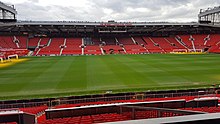
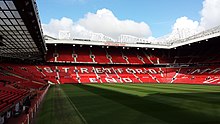
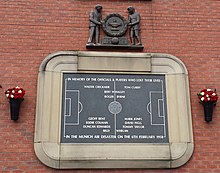


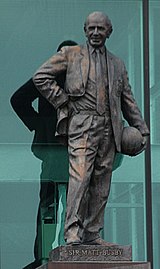



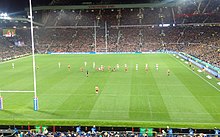

Old Trafford Cricket GroundOld Trafford (disambiguation)Sir Matt Busby WayOld TraffordTraffordGreater ManchesterEnglandWharfsideManchester United F.C.CapacityWolverhampton WanderersGrimsby TownDesso GrassMasterArchibald LeitchfootballManchester UnitedWembley Stadiumthe twelfth-largest in Europetram stopBobby CharltonMaine RoadManchester CitySecond World War bomb damageFA CupFA Cup Finalsemi-finals1966 FIFA World CupUEFA Euro 19962012 Summer OlympicsUEFA Women's Euro 20222003 Champions League Finalrugby leagueRugby Football LeagueSuper League Grand FinalPremiership FinalRugby League World Cup2021 (men's and women's)North RoadBank StreetClaytonJohn Henry DaviesFirst DivisionBridgewater CanalJ. J. BentleyCheshire Lines CommitteeTrafford ParkManchester Central railway stationManchester United Football GroundLiverpool1911 FA Cup FinalBradford CityNewcastle UnitedCrystal PalaceJimmy Speirs1915 finalSheffield UnitedChelseaAston VillaScotlandbombingWorld War IISecond World WarStockport CountyJames W. GibsonWar Damage CommissionEllis SmithBolton WanderersStretford Endfloodlightingprivate boxes1970 finalLeeds United1968 Intercontinental CupEstudiantes de La PlataTaylor Reportall-seatersEuro 962003 UEFA Champions League FinalJuventus2002–03AC MilanEngland national football teamVilla ParkSt James' ParkNewcastlePremier LeagueBlackburn RoversDavid MeekPat CrerandWilf McGuinnessHarold RileyJack CromptonDavid GillFulhamBilly MeredithDick DuckworthErnest Mangnallmen's tournamenta famous semi-finalwomen's tournamentSoccer AidRobbie WilliamsJonathan WilkesNational Health ServiceCOVID-19 pandemicManchester United women's teamWest Ham UnitedWomen's Super LeagueEvertonbehind closed doorsAustriaUnited KingdomRepublic of IrelandUEFA Euro 2028Alex FergusonPhilip JacksonMunich air disaster2018–19Sir Bobby Charlton1992–93 seasonAlfred McAlpineDenis LawBusby BabesSir Matt Busbyholy trinityGeorge Best